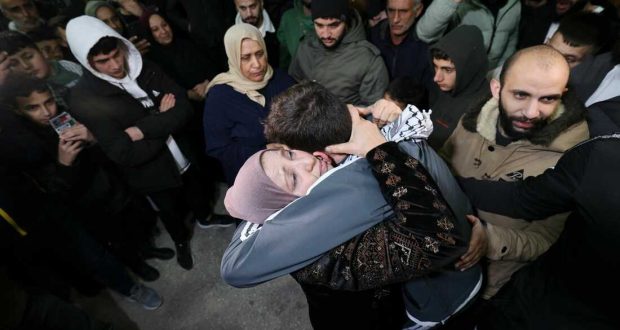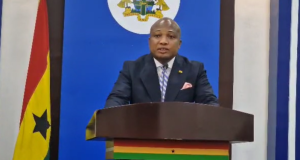Israeli forces and Hamas fighters abided by a truce for a fifth day on Tuesday, after a four-day ceasefire was extended at the last minute by at least 48 hours to let more hostages go free.
A single column of black smoke could be seen rising above the obliterated wasteland of the northern Gaza war zone from across the fence in Israel, but there was no sign of jets in the sky or rumble of explosions.
Both sides reported some Israeli tank fire in the Sheikh Radwan district of Gaza City in the morning, but there were no immediate reports of casualties. A spokesperson for the Israeli Defence Forces said: “After suspects approached IDF troops, an IDF tank fired a warning shot.”
During the truce, Hamas fighters released 50 Israeli women and children as young as toddlers from among the 240 hostages they captured in southern Israel during a deadly rampage on Oct. 7. In return, Israel released 150 security detainees from its jails, all women and teenagers.
Hamas also released 19 foreign hostages, mainly Thai farmworkers, under separate deals parallel to the truce agreement.
Israel has said the truce could be prolonged as long as Hamas continues to release at least 10 hostages per day. But with fewer women and children left in captivity, keeping the guns quiet beyond Wednesday could require negotiating to free at least some Israeli men for the first time.
“We hope the occupation (Israel) abides (by the agreement) in the next two days because we are seeking a new agreement, besides women and children, whereby other categories that we have that we can swap,” Hamas official Khalil Al-Hayya told Al Jazeera late on Monday.
Israeli security cabinet minister Gideon Saar told Army Radio that the two-day extension had been agreed under the terms of the original offer, and Israel remained willing to extend the truce further if more hostages were released.
“Immediately upon the completion of the hostage-recovery framework, the warfighting will be renewed,” he said.
Qatar, the main mediator of the truce in negotiations also involving Egypt and the United States, was now trying to secure a further extension based on Hamas releasing more hostages, its foreign ministry spokesperson, Majed Al-Ansari, said.
FIRST RESPITE
The truce brought the first respite to the Gaza Strip in seven weeks, during which Israel had bombed swathes of the territory, especially the north, including Gaza City, into a desolate moonscape. More aid was able to reach the territory, which had been under a total Israeli siege.
Israel has sworn to annihilate Hamas, the militant group that rules Gaza, after its gunmen burst across the fence and went on a violent spree, killing around 1,200 people and seizing 240 captives.
Since then, Gaza health authorities deemed reliable by the United Nations say more than 15,000 people have been confirmed killed in Israel’s bombardment, around 40% of them children, with many more dead feared to be lost under rubble.
More than two-thirds of Gaza’s 2.3 million people have lost their homes, trapped inside the enclave, with thousands of families sleeping rough in makeshift shelters with only the belongings they could carry.
When the war resumes, Israel has made clear it intends to press on with its assault from the northern half of Gaza into the south. U.S. officials said they have told their ally to be more careful about protecting civilians as its forces press on into areas where there are fewer opportunities to escape.
“You cannot have the sort of scale of displacement that took place in the north replicated in the south. It will be beyond disruptive, it will be beyond the capacity of any humanitarian support network,” one U.S. official said in a call with reporters. “It can’t happen.”
CLASHES OUTSIDE PRISON
Despite releasing 150 detainees under the truce, Israel has been arresting Palestinians far faster than it lets them go: according to the Palestinian Prisoners’ Club, a semi-official organisation, 3,290 Palestinians have been detained since Oct 7.
As Israel released the final 33 detainees under the original agreement on Monday night from its Ofer prison in the occupied West Bank, its forces clashed with some of the dozens of Palestinians waiting outside.
Some of the protesters waved the flags of Hamas and Islamic Jihad, another Palestinian militant group. The Palestinian health ministry said one Palestinian was killed in the area. Israel had no immediate comment on the incident.
Israel added an additional 50 Palestinian women to its list of 300 detainees cleared for release under the truce, seen as a sign it was prepared to negotiate for more hostages to go free under further extensions.
Any release of male Israeli civilians would be expected to begin with fathers and husbands captured along with the children and women freed in recent days, like Ofer Calderon, whose daughters Sahar and Erez were freed on Monday.
“It is difficult to go from a state of endless anxiety about their fate to a state of relief and joy,” said Ido Dan, a relative, about the release of the two girls.
“This is an exciting and heart-filling moment but … it is the beginning of a difficult rehabilitation process for Sahar and Erez, who are still young and have been through an unbearable experience.”
Israel’s siege has led to the collapse of Gaza’s health care system, especially in the northern half of the territory where no hospitals remain functioning. The World Health Organization said more Gazans could soon be dying of disease than from bombing.
WHO spokesperson Margaret Harris, citing a U.N. report on the living conditions of displaced residents from northern Gaza, said there was already a very high number of cases of infants suffering from diarrhoea: “No medicines, no vaccination activities, no access to safe water and hygiene and no food.”
Source: Reuters
 Public Agenda NewsPaper Ghana's only Advocacy & Development Newspaper
Public Agenda NewsPaper Ghana's only Advocacy & Development Newspaper






